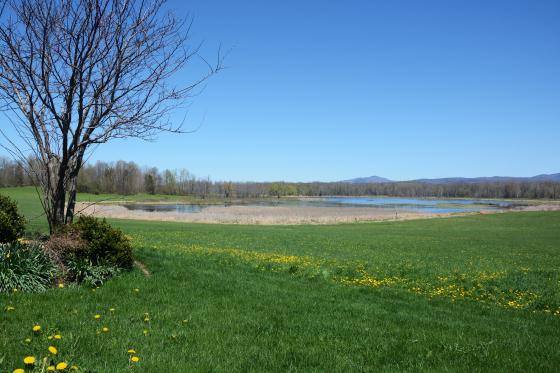Posted March 17, 2022 at 10:36am by Anonymous (not verified)
Spotlight on Wetlands in Vermont’s Otter Creek Watershed

Written By Amy Overstreet
Here in Vermont, wetlands help filter polluted runoff that could otherwise carry chemicals and bacteria into Lake Champlain and other waterbodies. But, half of the world's wetlands have disappeared since 1900. Development continues to pose threats to wetlands, even though their value and importance are obvious.
Here in Vermont, wetlands help filter polluted runoff that could otherwise carry chemicals and bacteria into Lake Champlain and other waterbodies. But, half of the world's wetlands have disappeared since 1900. Development continues to pose threats to wetlands, even though their value and importance are obvious.
So, why are wetlands important? Wetlands provide water storage which can prevent or alleviate flooding, and they also provide water quality protection, erosion control, fish and wildlife habitat, habitat for sensitive plants and animals, exemplary natural communities, education and research, recreation and economic benefits, and open space. And, studies have shown that wetlands can cost-effectively help reduce the excess nutrients coming off farm fields.
We know that one of the issues impacting the health of Lake Champlain, as well as the state’s most impaired watersheds, is agricultural activity. The result is nutrient pollution, or phosphorus runoff, which results in blue-green algae blooms and can produce toxins that are harmful to humans and other animals. Wetlands can play an important role in removing these pollutants. One of the most valuable services provided by functioning wetlands is their ability to protect downstream waterways from the negative impacts of nutrient pollution. They naturally “filter out” pollutants from water, acting as “nature’s kidneys.” Properly functioning wetland ecosystems helps absorb, transform, sequester, and remove the nutrients and other chemicals as water slowly flows through the wetland.
Wetlands protection and restoration helps move Vermont’s Farm to Plate food system plan in a positive direction. Wetlands conservation promotes both nutrient management and land conservation as well as showing how environmental stewardship can deliver a net environmental benefit to Vermont. There’s a perfect example of this type of net environmental impact in Vermont’s Otter Creek Watershed. Here, a number of privately owned wetlands have been, or will soon be, restored and protected through the Agricultural Conservation Easement Program (ACEP). Administered by the USDA Natural Resources Conservation Service (NRCS), ACEP offers financial and technical assistance to landowners who want to voluntarily restore and protect wetlands. Once restoration is completed on the most recently acquired wetland easement, over seven miles of wetlands and riparian areas along the Otter Creek will be restored and protected. That’s landscape-scale conservation at work.
The Des Marais Farm in Brandon, Vermont, is part of the growing community of private wetland landowners that are restoring these important natural areas. Jim and Lyn Des Marais enrolled nearly 500 acres into ACEP, making it the state’s largest privately protected wetland easement.The Des Marais property was once farmed and the area was ditched to control water flow. The ACEP restoration plan will plug the ditches so that water can flow naturally again throughout the wetland. In addition, small depressions will be added to provide improved habitat for migratory waterfowl, shorebirds, and amphibians. The Des Marais wetland is a paradise for birds. It’s home to ducks, rails, herons, bald eagle, peregrine falcon and other woodland hawks. The area also provides a resting and breeding habitat for resident birds. The family works with a local farmer that leases their land for organic hay to delay the first cut on around 200 acres to protect birds and their eggs.
Twenty years ago, Lyn Des Marais fell in love with the farm that is now their home. Jim Des Marais grew up in Vermont and attended Woodstock Union High School and the University of Vermont. He moved away, but would visit home regularly to see his parents in Vermont. During these visits, Lyn says she would get in the car and drive, looking at the rolling green hills of Vermont. She fell in love with this particular farm and set her mind to one day living there. When the property was finally put on the market in 2013, they made an offer, packed up their belongings, and left London to make their home in Vermont.
Together, the combined stewardship of private landowners in Rutland County is helping to protect and improve water quality in the Otter Creek Watershed and beyond. Wetlands conservation helps protect water quality by trapping sediments and retaining excess nutrients and other pollutants. These functions are especially important when a wetland is connected to groundwater or surface water sources, like Lake Champlain, that are used by us for drinking, swimming, fishing, or other activities. Wetlands are the link between land and water. And here in Vermont, wetlands conservation is making a difference in the health of our natural resources.
To learn more about wetlands protection and restoration, visit the NRCS website.
